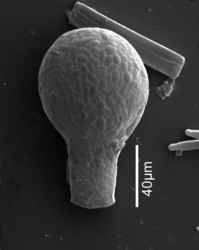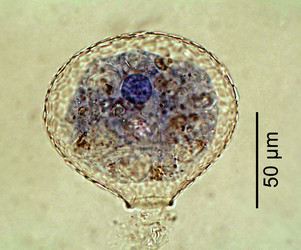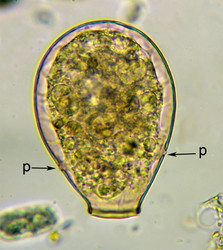Nebela
Ralf Meisterfeld and Edward MitchellIntroduction
The genus Nebela is dominant in mosses and humus-rich soils. Nebela species can be as small as 30 µm but can reach up to 380 µm (N. maxima).
Loeblich & Tappan (1964) have designated Nebela numata Leidy, 1874 as valid type species which unfortunately is a junior subjective synonym of Nebela collaris (Ehrenberg, 1848).
Characteristics
The test can be ovate, pyriform, elongate or with a long neck, but always compressed, sometimes with lateral pores (e.g., N. tincta, Fig. 1). Their colour is yellowish, transparent often with predated siliceous plates or diatom frustles in an unstructured organic cement. All species have an ovular nucleus.
Discussion of Phylogenetic Relationships
The molecular data of Lara et al. (2008) suggest that the genus is probably paraphyletic. Taxa described as varieties may deserve the rank of species. This would increase the number of species significantly.
Ecology
Most Nebela spp. are predators of small Euglyphida. Habitat: common in mosses (Sphagnum) and soil. Additional ecological data: Bonnet (1990), Tolonen et al. (1992).
References
Deflandre, G. 1936. Etude monographique sur le genre Nebela Leidy (Rhizopoda - Testacea). Ann. Protistol., 5:201-286.
Jung, W. 1942b. Illustrierte Thekamöben-Bestimmungstabellen. I. Die Systematik der Nebelinen. Arch. Protistenk., 95:357-390.
Lara, E., Heger, T.J., Ekelund, F, Lamentowicz and Mitchell, E.A.D. 2008: Ribosomal RNA Genes challenge the monophyly of the Hyalospheniidae (Amoebozoa: Arcellinida). Protist 159: 165-176.
Ogden, C. G. & Hedley, R. H. 1980. An Atlas of Freshwater Testate Amoebae. Oxford University Press, Oxford.
Rauenbusch, K. 1987. Biologie und Feinstruktur (REM- Untersuchungen) terrestrischer Testaceen in Waldböden (Rhizopoda, Protozoa). Arch. Protistenk., 134:191-294.
Tolonen, K., Warner, B. G. & Vasander, H. 1992. Ecology of Testacea (Protozoa, Rhizopoda) in Mires in Southern Finland. 1. Autecology. Arch. Protistenk., 142:119-138.
Bonnet, L. 1990. Données écologiques sur quelques Hyalospheniidae et Paraquadrulidae (Thécamoebiens) des sols (Deuxième partie: genre Nebela). Bull. Soc. Hist. Nat. Toulouse, 126:9-17.
Title Illustrations

| Scientific Name | Nebela carinata |
|---|---|
| Specimen Condition | Live Specimen |
| Identified By | Ralf Meisterfeld |
| Copyright |
©

|
About This Page
This page is being developed as part of the Tree of Life Web Project Protist Diversity Workshop, co-sponsored by the Canadian Institute for Advanced Research (CIFAR) program in Integrated Microbial Biodiversity and the Tula Foundation.

Rheinisch-Westfälische Technische Hochschule Aachen, Germany
Edward Mitchell

University of Neuchâtel
Correspondence regarding this page should be directed to Ralf Meisterfeld at and Edward Mitchell at
Page copyright © 2008 and Edward Mitchell
All Rights Reserved.
- First online 02 September 2008
- Content changed 02 September 2008
Citing this page:
Meisterfeld, Ralf and Edward Mitchell. 2008. Nebela . Version 02 September 2008 (under construction). http://tolweb.org/Nebela/124530/2008.09.02 in The Tree of Life Web Project, http://tolweb.org/













 Go to quick links
Go to quick search
Go to navigation for this section of the ToL site
Go to detailed links for the ToL site
Go to quick links
Go to quick search
Go to navigation for this section of the ToL site
Go to detailed links for the ToL site